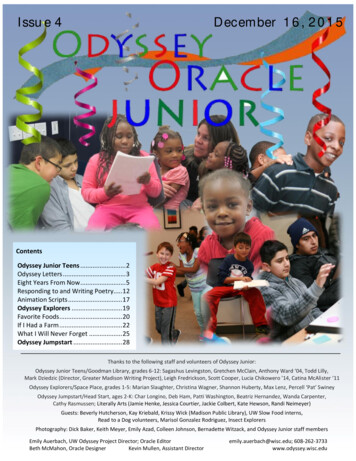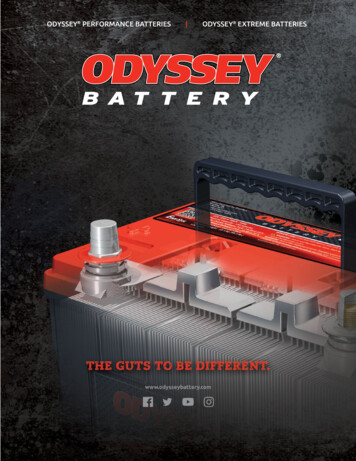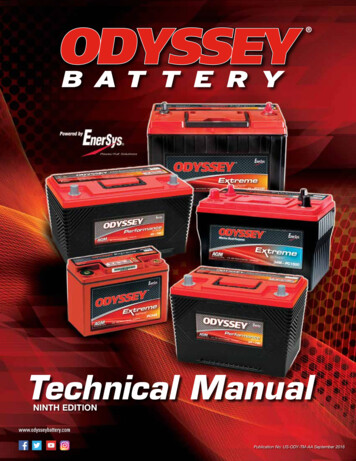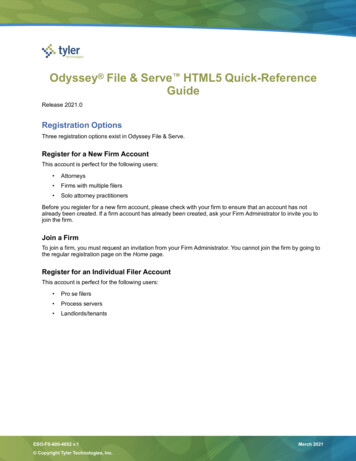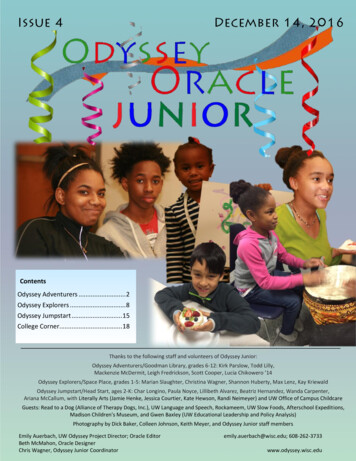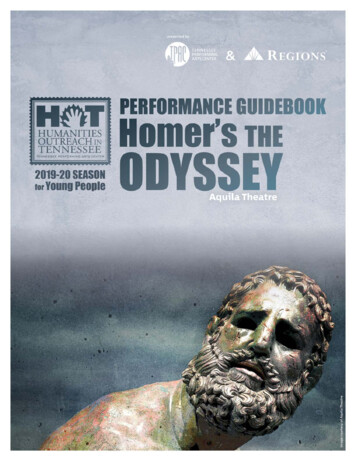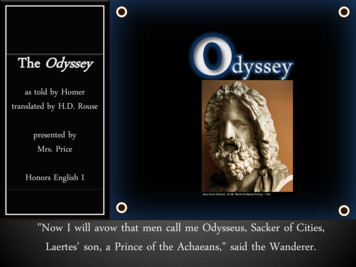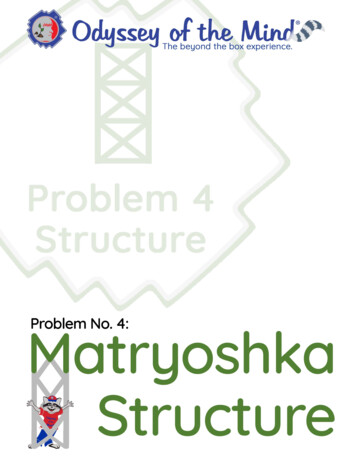
Transcription
Matryoshka StructureProblem No. 4: Divisions I, II, III & IVA. The ProblemIt’s always the more the merrier with nesting dolls, also known as Matryoshka! In this problem, teams will design andbuild a Matryoshka Structure made of only balsa wood and glue that holds as much weight as possible. The structurewill hold additional structures nested one inside the other. The more structures that are nested, the higher the score!Before weight placement can begin, the nested structures will be removed one-by-one to reveal a tiny character nestedinside the smallest structure. The performance will star the tiny character and have a theme about storage that includesplacing weights and the structures.The creative emphases of this problem are on the performance, the way the Matryoshka Structure is designed to holdnested structures and be disassembled and reassembled, the tiny character’s portrayal by a team member, and howstorage and weight-placement are presented in the performance.The Spirit of the Problem is for the team to design, build, and test a Matryoshka Structure— a structure with smallerversions of it nested inside. The structures must only be made of balsa wood, glue if desired, and the outer structure willbe tested by placing as much weight as possible onto it. Before weight-placement begins, the assembled structures aredisassembled into two interconnected parts to remove the next structure from largest to smallest until a tiny characteris released. The performance will imitate the structures being removed with a team member that represents the tinycharacter being revealed and coming to life. It will also include storage in the theme.B. Limitations (Italicized words/terms are defined in the 2021-22 Odyssey of the Mind Program Guide or the ProblemGlossary.)1.General Rules: Read the 2021-22 Odyssey of the Mind Program Guide. This manual is updated each year andincludes important rules for solving the Odyssey of the Mind problems and forms required for competition. Thisproblem cannot be solved without referring to the Program Rules section of the Program Guide.2.Problem Clarifications: The Odyssey of the Mind Program Guide explains the types of questions that will be clarified andhow to submit them. Problem clarifications can be submitted and accessed at www.odysseyofthemind.com/clarifications.The deadline for submission is February 15, 2022. CCI may find it necessary to issue clarifications after that date,so continue to check for them after February 15 and before each competition.3.The time limit for this problem is 8 minutes. This starts when the Timekeeper says, “Team Begin,” and includessetup, removing the structures and tiny character, Style, the presentation of the solution and testing the structure.Time ends when the team finishes or the Timekeeper says, “Time,” whichever comes first.4.The cost limit for this problem is 125 (U.S.). The combined value of all materials used during the presentation ofthe solution, including Style, cannot exceed this amount. The balsa wood used in the structure tested for weight heldand the nested structures are exempt from cost. The Odyssey of the Mind Program Guide explains the cost limit andlists items that are exempt from cost.5.The team’s solution will be presented in an original performance that includes:a.a Matryoshka Structure made of only balsa wood. Glue may be used to hold the pieces of balsa wood together.b.additional structures nested inside the Matryoshka structure and each other.c.a tiny character nested inside the smallest structure.d.a team member that portrays the tiny character.e.a theme that includes storage.f.five Style elements including two that are chosen by the team listed in F. Style.Page 1 of 7
6.7.The Matryoshka Structure:Figure A: Top Viewof the Openinga.and nested structures must be made of only balsa wood and glue, if desired, that is used toconnect the balsa wood.b.must weigh no more than 15 grams including glue for Divisions II, III, & IV and no morethan 18 grams for Division I. This does not include the nested structures and the tinycharacter.c.will hold the smaller versions nested inside itself. Only this outer “Matryoshka Structure”will be tested for weight-held.d.must be a minimum of 8” (20.32cm) in height when resting on the Tester base andsupporting the Crusher Board (see Fig. B) and another weight. Extension pieces used to meet minimum heightlimitations but not to support weight, as determined by the judges, are not allowed.e.must be a single assembled structure that is designed and built by team members without any outside influence(see B21).f.may be built using other items and/or devices; however, these must be removed before the structure goesthrough the Weigh-In process (see C2-4).g.must have an open area running the entire height that will accept a column that is 2” (5.1cm) in diameter whenbeing used for testing. Therefore, when being tested, the opening in the structure must be greater than 2”(5.1cm). This opening will be measured at Weigh-In. The safety pipe must pass through the opening of thestructure during weight placement (see Fig. A.).h.must contain all the nested items and the tiny character before time begins. It will move as one when assembledand nested and must remain nested when it is turned sideways and upside down.i.must be disassembled after time begins into two parts to remove the nested contents and then put back togetherfor testing.The balsa wood used in the structures:a.must come from only commercially produced strips of balsa wood. No other type of balsa wood or any variationof balsa wood may be used. Balsa wood may be purchased through www.odysseyofthemind.com/shop — anybalsa purchased from here during the current program year will be considered as being within the limitations.Teams must provide an invoice from CCI that shows the purchase information including the date of thetransaction. Balsa used in the structure does not count towards the cost limit. If balsa is used as any other partof the presentation, that balsa counts toward the overall cost.b.must come from strips with a cross section of 1/8” x 1/8” (0.32cm x 0.32cm) that are at least 36” (0.91m) longwhen the team receives it. It is not allowed to be cut by the team into strips from oversized wood (greater than1/8” in width or depth) to meet the 1/8” (0.32cm) cross section limitation.c.must have a 1/8” x 1/8” deep (0.32cm x 0.32cm) cross section for most of its length. Some commercial cuts vary,so the allowed cross section dimensions enforced will be 0.115” to 0.135” (0.29cm to 0.34cm). Any piece thatdoes not have a cross section within 0.115” to 0.135” (0.29cm to 0.34cm) will be considered a prohibited piece.Teams are allowed to sand or carve pieces of wood in small areas to form joints as long as the cross section forthe rest of its length beyond the joints is within this range.d.is not allowed to be hand-picked by anyone other than team members. Team members may request wood to befrom a commercially available grade, but no one else may sort and pick specific pieces.e.must be cut by the team. The only exceptions are the perpendicular end cuts of the original strip as defined inB7a & b.f.must be used “as is.” The wood is not allowed to be strengthened in any way. Use of water or hot and/or coldair are not considered strength-enhancing.Page 2 of 7
8.9.If glue is used in the structures:Figure B: Tester Designa.must be a commercial brand that has the word“glue,” “epoxy,” “cement,” or “adhesive” printedby the manufacturer on its label (container and/or packaging). More than one type of glue maybe used. The container, packaging, or purchaseinvoice from any glue used in the structure must bebrought to Weigh-In to ensure there is no penaltyfor a substance other than glue being used.b.must be used as purchased. That is, nothing maybe added to it, and it is not allowed to be mixed withanything unless the manufacturer specifies thatthe ingredients, sold together, combine to form theglue. Accelerants are not allowed to be used.c.must only be used to adhere pieces of balsa wood together to form two single, interconnected parts.Judgements dealing with measurements, weight, wood, the “open area” (see Fig. A) and artificial strengthening willtake place at the Weigh-In Site before competing. Judges not associated with Weigh-In may bring certain mattersto the attention of the Weigh-In Judges. Penalties may be given before and/or after a team has competed.10.11.12.13.The structures nested inside the Matryoshka Structure:a.must be completely inside the structure to be considered nested. That is, a nested structure is not allowed tobreak the exterior plane of the structure it is nested within. For example, when a team member picks up theMatryoshka Structure and moves it to a different location while remaining in an upright position, all nested items(structures and character) will remain inside of the structure nesting it and move to the same location.b.must be made of only balsa wood and glue. All rules from B7 & B8 apply to the nested structures.c.will receive score for how much they look like smaller versions of the Matryoshka structure.d.will be scored as follows: 1 nested 5 pts, 2 nested 10 pts, 3 nested 20 ptse.if there are no nested structures the team will receive a score of zero for D5a and Penalty E12.f.must also be able to be disassembledUnnesting the structures and tiny character will take place one at a time, from largest to smallest, before weightplacement can begin and will be done by the team this way:a.Disassemble the Matryoshka Structure into two parts.b.Remove the structure inside. All other nested items must be inside the structure that is removed. The Matryoshkastructure may be placed on the tester as the next steps continue.c.Disassemble the structure that was removed into two parts and continue for all nested structures.d.When the Tiny Character is removed from the last structure weight placement can begin.The tiny character nested inside the smallest structure:a.must be the last item removed from the nested structures.b.does not have to be made of balsa wood.c.will be portrayed by a team member in the performance. As the tiny character is removed from the structure,the team member portraying the tiny character will also be revealed in the performance.The performance:a. will mimic the nested structures being removed and the tiny character being revealed.b. can have a theme about anything the team wishes, but it must include storage, the structures being revealed,and the tiny character.Page 3 of 7
14.Team members must place weights one at a time onto the structure. The first weight must be the Crusher Boardsupplied by the Tournament Director. This will count towards weight held.15.Team members are required to safely select, lift, carry, and place weights onto the structure. Division I and DivisionII teams are not required, but are allowed, to have adult assistance in placing weights as follows:a.Adults are not allowed to help any team in any division select weights for placement.b.Division I and II teams will determine if they will use limited adult assistance*. They may use adult assistanceat any time during weight-placement from when the weight has been selected by the team until it is resting inplace on the weight stack.c.Division I teams may have an adult assist at least one team member in placing weights heavier than 20 lbs.d.Division II teams may have an adult assist at least one team member in placing weights heavier than 40 lbs.e.The adult is only allowed to help. If the judges determine an adult is selecting a weight, or is doing more thanassisting one or more team members, they will instruct the team to remove the weight and place it back onto theunused weights before continuing weight placement. If the weight would not fall to the floor if the team memberwere to let go, the adult is breaking the rules. There are no other constraints on adult assistance.*only one adult (18 years or older) is allowed to be on the competition site and assist the team at any time. The adult isallowed to help one or more team members lift, carry, and/or place weights onto the stack (per limitations). The adult isallowed to assist in placing the weights whether or not they helped carry the weight to the Tester.16.Team members must wear safety goggles, eyeglasses with plastic lenses, or other protective eyewear (approved bythe judges) if they are within the Safety Area with their head below the level of the Crusher Board while the structureis supporting weight. This applies to everyone in the Safety Area (see E10).17.A weight must be held on the stack for at least 3 seconds to count in the total weight-held score.18.If the weight stack reaches the top of the safety pipe, it is the team’s responsibility to add an extension pipe to thesafety pipe (if provided by the Tournament Director).19.The team should present the Staging Area with four copies of the Team List Form found in the forms section atwwww.odysseyofthemind.com/members or four copies of a list on one side of one or two sheets of 8 ½” x 11” or A4paper. This list can be hand-printed or computer-generated. It is for reference only. The list must include:a. the team’s membership name and number, the problem and division.b. the number of structures nested inside the Matryoshka Structure for score.c. a brief description of the tiny character and how the team member that portrays it will be revealed in theperformance.d. the signal the team will use to indicate it has finished its performance (weight-placement can continue if timeallows).20.The team must use only the weights and tester supplied by the tournament director. These can only be used inthe normal process of placing weights; for example the weights cannot be used for style, the tester cannot bedecorated, etc.21.A reminder about Outside Assistance: All Outside Assistance rules apply. Team members are responsible for makingan original design and building an original structure. Photographing or otherwise referencing other teams’ solutionsis Outside Assistance.C. Site, Setup and Competition1.A stage or floor area a minimum of 14’ x 14’ (4.3m x 4.3m) will be used, but a larger area is desirable. This will notbe marked. Teams must be prepared to perform in a 14’ x 14’ (4.3m x 4.3m) area. If space permits, the team mayperform and/or place equipment, props, etc. outside the area. If a drop-off exists beyond the dimensions, a cautionline may be taped 30” (76.2cm) from the edge of the drop-off. This will serve as a warning, not a boundary.2.Each competition might have specific times to report to Weigh-In, but generally teams report to the Weigh-In Site withits Matryoshka Structure, nested structures, tiny character, and glue, if used, to have it checked for specificationsat least 40 minutes before its scheduled performance time. The structure being tested should be brought to weighin without the nested structures and tiny character inside so it can be weighed. The nested structures will alsobe checked for appearance, and then the team can nest the structures and the tiny character to be ready for theperformance to begin.Page 4 of 7
3.If the Matryoshka Structure or any nested structures do not meet specifications, Weigh-In judges will try to give theteam an opportunity to bring it into specification or submit a different structure before the team’s competition time. Inmost cases, corrections should be completed no less than 20 minutes before competition time. There is no penaltyif the structure is brought into specification before completing the Weigh-In process.4.The assembled Matryoshka Structure, with all contents removed, will be weighed and measured. The team will thennest all the structures and tiny character into the Matryoshka Structure. A judge will provide the team with a bag,or the team can use its own container if it is approved by the Weigh-In officials to store the Matryoshka Structure.The team will place the structure into the bag/container and the judge will attach a Weigh-In Checklist to it. Thestructure will remain at the Weigh-In Site until the team picks it up for competition. The team must return to pick upits structure no later than 25 minutes before its scheduled competition time.5.Team members must report to the competition site with everything they will use in their solution at least 20 minutesbefore they are scheduled to compete. The team is not allowed to remove the Weigh-In Checklist until directed todo so by the Staging Area Judge. If the Weigh-In Checklist has been removed, the bag or container tampered with,or the structure removed, the team may have to repeat the Weigh-In process. Depending on the situation, the teamcould receive a Spirit of the Problem penalty.6.The team should inform the Staging Area judge if it expects to continue its performance after the structure breaks.Should the team finish its performance before the structure breaks and has given the signal to end the performance,the team will be allowed to continue placing weights until any one of the criteria from C10 or C13 occurs.7.Teams should bring cleaning utensils to clean up any mess. Should a team take an unreasonable amount of timeto clean the site, or leave a mess, the judges will assess an Unsportsmanlike Conduct penalty. Others not on theteam’s roster may help the team clear the site and remove the team’s props. The competition area must be left cleanand dry for the next competing team.8.A three-prong electrical outlet will be available at the performance area. Teams must bring their own extension cordsand adapters, if needed.9.If possible, the Tester will be on a solid, level floor. The Tester will be positioned in the center of a Safety Area, a 60”x 60” (1.5m x 1.5m) taped square, which will serve as a guide so team members are aware of their proximity to theTester and as a reminder of where they must wear safety glasses. The team is not allowed to move the Tester.10.The team has 8 minutes to test its structure and present its performance. The team must stop all activity when thejudge calls “time.” Or, the team may give a signal indicating the performance portion is over.11.The nested structures and Tiny Character must be unnested before weight-placement can begin. Time will continue.12.The team is allowed to touch and adjust the structure while placing the Crusher Board on it and while placing thefirst weight onto the Crusher Board. They are not allowed to touch the structure once the team begins to placeweights onto the Crusher Board. If the team wishes to adjust the structure, they must remove all weights. They areallowed to remove the Crusher Board, but it is not required. Team members may then touch the structure beforeresuming weight placement.13.If any of the following occur, all weight-placement will end when:a.b.c.d.e.the Crusher Board or any part of the structure touches any corner post.any part of the structure touches anything other than the surface of the Tester base and the bottom of theCrusher Board.the top weight rests against the safety pipe and the judges determine that the pipe is helping to support theweight stack. If time remains, the team will be given the opportunity to adjust that weight and continue weightplacement.a weight extends beyond the height of the full length of the safety pipe, including extension pipes, if providedby the tournament director.the team indicates it wishes weight placement to stop.Page 5 of 7
D. Scoring1.Overall creativity of the performance. 1 to 15 points2.Overall quality of the presentation. 1 to 10 points3.Weight Held (calculated based on the most weight held in that competition). 1 to 100 pointsIn each division, the team with the highest weight-held score will receive 100 points. All other structures will receivea corresponding score based on the percentage of weight held.)4.The Matryoshka Structure. 3 to 25 pointsa. is disassembled into two parts and reassembled into one. 0 or 10 pointsb. creativity of its design.3 to 15 points5.The nested structures inside the Matryoshka Structure. 0 to 25 pointsa. 1 nested 5 pts, 2 nested 10 pts, 3 nested 20 pts. 0, 5, 10 or 20 pointsb. look like smaller versions of the Matryoshka Structure. 0 or 5 points6.The Tiny Character is the final item nested within the smallest structure. 0 or 5 points7.The team member representing the tiny character. 1 to 10 pointsa. is revealed when the Tiny Character object is released. 0 or 5 pointsb. Impact of the Tiny Character’s portrayal in the performance.1 to 5 points8.How storage and weight placement are integrated in the theme. 1 to 10 pointsa. Includes storage in the theme. 0 or 5 pointsb. Creativity of how storage and weight placement are presented.1 to 5 pointsMaximum possible: 200 pointsE. Penalties1.Spirit of the Problem violation (each offense).-1 to -30 points2.Unsportsmanlike conduct (each offense).-1 to -30 points3.Missing membership sign or wrong team/problem/division.-1 to -5 points4.Outside assistance (each offense).-1 to -25 points5.Having someone other than team members cut pieces of wood,apply glue, or work on the structure in any way.weight-held score of zero6.Over cost limit.-1 to -30 points7.Artificially strengthened structure.-5 points to weight-held score of zero8.Structure does not meet specifications and is not corrected before completing Weigh-In*:a. Overweight structure (Weight will be determined by the official gram scale for each competition.): Any structureweighing more than 15 grams (18 grams for Div. I) will receive -5 points for every 0.1 gram overweight up to 2grams. Two or more grams overweight will receive zero score for weight-held. The penalty must not exceed thecalculated weight-held score.b. Undersized or Oversized Wood per B7c. weight-held score of zero(Not assessed if it is an irregularity of that piece and the rest is within limitations)c.Undersized Structure:(1) Less than 8” (20.32cm) but more than 7-7/8” (20cm) high. - 50 points(2) 7-7/8” (20cm) or less.weight-held score of zero9.Open area does not accept the 2” (5.1cm) diameter columnthrough its entire height.weight-held score of zeroPage 6 of 7
10.If any team member is not wearing safety glasses while inside the Safety Area with their head below the CrusherBoard, the team must stop weight placement until that team member puts on safety glasses. Time will continue.11.If an adult selects a weight or places it without direction and help from a team member, that weight does not counttoward weight-held score. The weight must be removed. It may be placed again properly for score. A judge will warnthe team and the adult. If this continues after two warnings, a 10-point Outside Assistance penalty will be assessedfor each future occurrence.12.Zero nested structures.zero score for D5a and -15 points Spirit of the Problem Penalty*These penalties will be substituted with a weight-held score of zero if, in the aggregate, that is less of a penalty. Teams thatdon’t present a scored element of the problem (see D. Scoring) will not receive a penalty; they will receive a zero score forthat category, except for having zero nested structures.F. Style(Elaboration of the problem solution; use four copies of the Style Form from the 2021-22 Odyssey of the MindProgram Guide.)1.Creative use of a trash item in a backdrop or prop . 1 to 10 points2.Effectiveness of the way a character other than the Tiny Character moves. 1 to 10 points3.(Free choice of team). 1 to 10 points4.(Free choice of team). 1 to 10 points5.Overall effect of the four Style elements in the performance. 1 to 10 pointsMaximum possible: 50 pointsG. Tournament Director Will Provide1.At the Weigh-In Site:a.b.c.d.e.f.2.a gram scale accurate to 1/10th of a gram.a micrometer or other precision method of checking wood thickness.an accurate ruler or device to measure the structure’s size requirements.a 2” (5.1 cm) diameter column-measuring device.a bag to hold the team’s assembled structure.tape to attach the Weigh-In Checklist to the bag.At each competition site:a.b.c.d.e.f.g.a 14’ x 14’ (4.3m x 4.3m) competition area (larger if possible) with a taped safety area.a three-prong electrical outlet reaching the performance area.a Tester and a 60” x 60” (1.5m x 1.5m) taped Safety Area.a 12” (30.48cm) extension to the safety pipe (if available).three pairs of safety glasses: one to be used by a judge and two that are available to the team.a judging team and all materials necessary to judge this problem.a minimum of 400 lbs. of weights in assorted sizes, generally from 5 lbs. to 45 lbs. (2.28kg to 20.41kg), eachwith a hole 2” (5.1cm) in diameter. When registering for a tournament, teams needing more weight should notifythe Tournament Director. Teams are not allowed to bring and use their own weights.Note: Contact your Tournament Director for information regarding specific competition sites such as actual dimensions,amount and size of weights, weight of the Crusher Board, registration procedures, floor surface, etc. Do not submit aclarification request for this information.H. The Team Must Provide1.Four copies of its Style Form, one Cost Form, one Outside Assistance Form, and all of its team clarifications.2.Four copies of the Team List. This list is to assist the judges. If the team fails to provide the list, there will be nopenalty; however, it benefits the team to have the lists because without them the judges might miss a scored aspectof the performance.Page 7 of 7
3.Safety glasses or other eye protection. However, the team may use up to two pairs of goggles provided by theTournament Director.4.Any necessary extension cords or adapters.5.Cleanup materials as needed.I. Metric Equivalency ChartLengths:1 inch 2.54 cm1 foot 30.48 cm1 cm .39 inches1 meter 3.28 feetWeights:1 ounce 28.35 grams 1 gram .035 ounces1 pound .45 kilograms 1 kilogram 2.2 poundsJ. Problem Glossary (Italicized terms that are not in this Glossary can be found in the 2021-22 Odyssey of the MindProgram Guide)Interconnected - parts must be connected and not simply be touching. Touching alone is not considered interconnected.Assembled - No more than two separate interconnected structure parts, reassembled into one structure. Whenassembled into one single structure and held at any point of contact, may be lifted straight up, moved to another location,placed back down, and remain connected as a single assembled structure. Pieces may change their orientation orposition but they must be able to move as one unit.Nested - A set or series of similar things, each fitting completely within another version the next size larger.Creative Competitions, Inc., its licensees, and the problem authors assume no responsibility for damage or injuryincurred as a result of attempting to solve this problem.Problem by Dr. C. Samuel Micklus and Samuel W. Micklus. Copyright 2021 — Creative Competitions, Inc. Odyssey of the Mind, OotM, OM, the Odyssey of the Mind logo, and OMER are federally registered trademarks ofCreative Competitions, Inc.P R E C AU T I O N S Use eye protection, e.g., a face shield, safety glasses, goggles, etc., when looking closely at a structure holdingweight. Collapsing structures may project pieces of wood several feet. Keep your fingers on the sides of the weights when placing them onto the Crusher Board or onto other weights. Remain aware of the structure, the testing device, and the weight stack at all times to avoid injury in case ofcollapse. Do not stand too close to the structure, Tester, and w
B. Limitations (Italicized words/terms are defined in the 2021-22 Odyssey of the Mind Program Guide or the Problem Glossary.) 1. General Rules: Read the 2021-22 Odyssey of the Mind Program Guide. This manual is updated each year and includes important rules for solving the Odyssey of the Mind problems and forms required for competition. This
